Ronde van Vlaanderen Preview
- Rúben Silva
- Apr 5, 2019
- 14 min read
Updated: Apr 6, 2019
It's the first Sunday of April and we know what that means. It's time for de Ronde! The most iconic of the Flandrien classics, the climax of the Belgian cobbled racing and the second monument of the season. The race goes through the most iconic Flandrien bergs, the Muur de Geraardsbergen, the Oude Kwaremont and the Parerberg, and is for many (especially the Belgians) the main goal of the season.
Obviously the former winner list here is hard to beat, Fabian Cancellara, Tom Boonen and Johan Museeuw hold the record of wins here, each one with 3 in the books, and with 5 former winners set to start out and several other in the mix we are in for a great one.
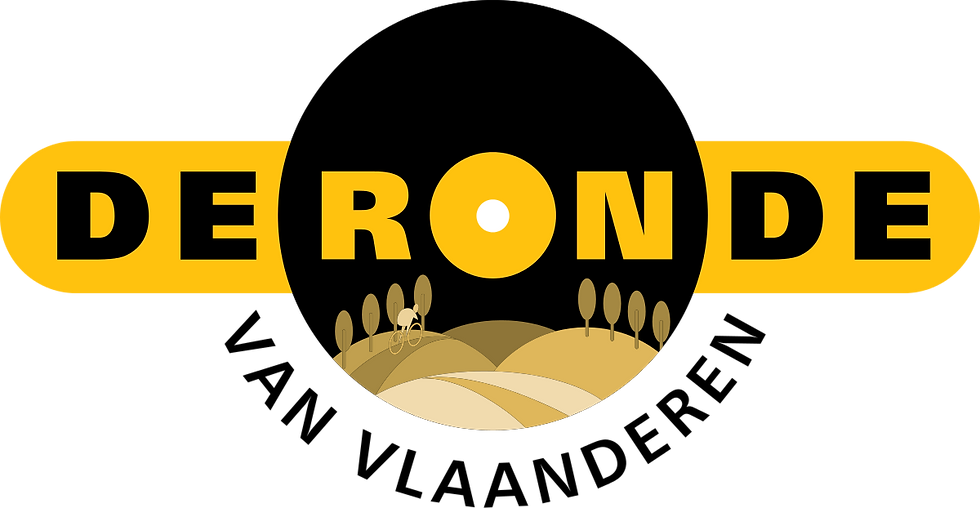
The Route
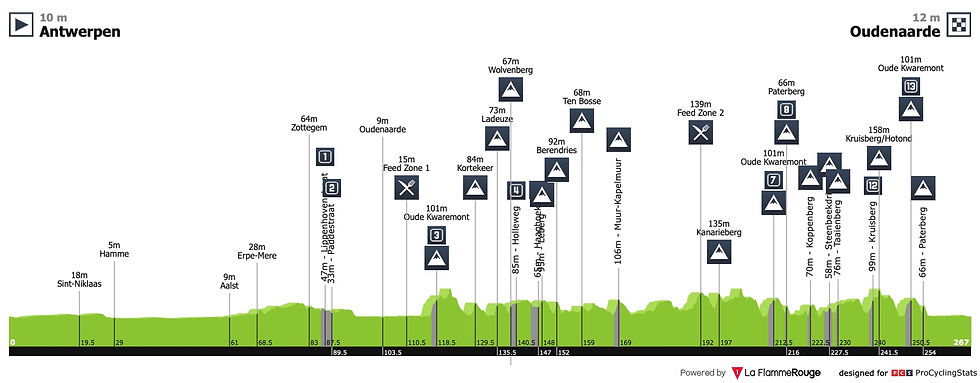
The route, like it's former editions is a long one, one of the longest races in the calendar with 267 kilometers en route to Oudenaarde. It's a familiar one too, with no major changes this year, the riders will go through the bulk of the central Flandres region coming from Antwerp as it's been the case since 2017.
The first 80 kilometers will be run in mostly flat roads with no dificulties to take, but the situation will only be disrupted with two short cobbled sectors including the Paddestraat, but with a big flat run-in after it surely it's still a point of the race where everyone will still be trying to save their legs.
After 115 kilometers of racing do we finally get to the first crucial point of the race.

The first of three passings on the Oude Kwaremont symbolizes the entrance in the hills, entering this sector means the race is on, into the roller-coaster the profile becomes. After comes a combination of paved and cobbled climbs, the cobbled include the Wolvenberg and the Leberg, but with a lot of dificulties between and arount them. The first passing comes 148 kilometers away from the finish which is too far to make real differences, but that set of climbs finishes with 108 kilometers to go, so some attacks may occur, alongside a lot of damage in the peloton.

In the flattest part of the bulk of the race the race goes through Geraardsbergen where ironically may be the hardest climb of the race. Located 98 kilometers away from the finish it may look far but it's where in 2017 the decisive move was made, with eventual winner Phillipe Gilbert took off with a large group ahead and eventually went on to solo away to victory. It's an important part of the route, the teams will have a chance to organize themselves before this point of the race, but the Muur will likely set the race into shambles once again, maybe definetely this time.
For around 20 kilometers there's a somewhat flat terrain, which will surely allow for a regrouping in the race, a calm moment before the return to the main racing area and the climbing will come relentless.
Although not the hardest of parts in the race it's still hard, including the brutal Kanarieberg before the riders return to the Oude Kwaremont.

With 55 kilometers to the finish they will summit the Oude Kwaremont for the second time, it's the longest climb of the race with 2200 meters at an average of 4.2% and a maximum of 11% right in it's begining. Entering from a false flat the first ramp is the hardest, and the cobblestones make for an even more dificult challenge than what it would already be in normal conditions.
At this point there's no slowing down in the race, it's all up-and-down until the run-in to Oudenaarde. The Paterberg follows, and after that comes the Koppenberg. It's 600 meters at 11% pitching up to 22%, also one of the hardest climbs in Flandres and a place where it's mostly leg-sapping more than attacking, as the speed barely allow anyone to accelarate.
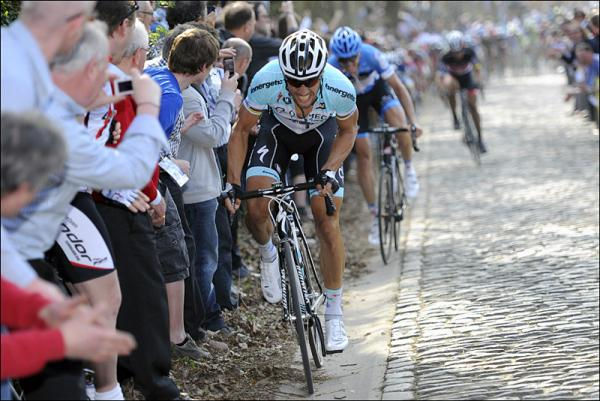
The Steenbeekdries/Taaienberg combination follows, just as it did in E3 Binckbank, the summit of the Taaienberg comes with 37 kilometers to go, with ramps of 18% within the sector, but the real differences can be made after the steep pitches, accelarating on the remainder of the sector and right after.
After the race moves to the Oude Kruisberg and Hotondberg combination. The Kruisberg is where Niki Terpstra attacked last year heading on to his win, and presents the final challenge before the final climb set.
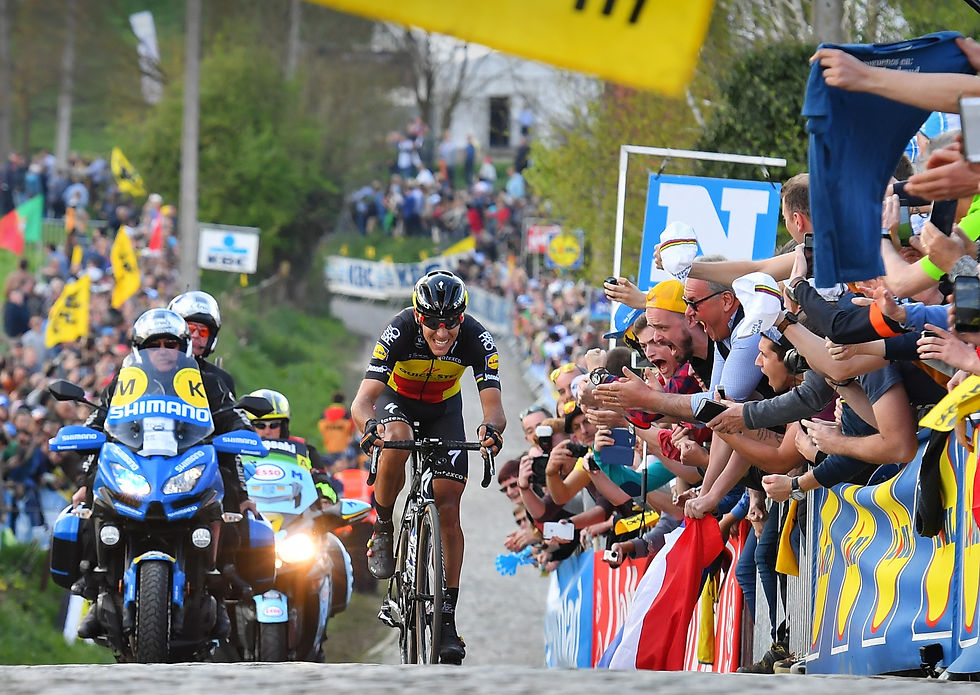
That is, of course, the 3rd and last ascent of the Oude Kwaremont, that will quickly lead into the final climb of the day, the Paterberg. It's the 2nd time over it, it's the final opportunity for the real blows to be dealt, it is 400 meters long at 12.5% average gradient with 20% in it's hardest part.
It's summit is 13 kilometers away from the finish and from there on it's just flat until the finish line.

But this is not an ordinary flat run-in. With the race often split into pieces, with tactical games being played and over 6 dreadful hours in the rider's legs this may be the hardest kilometers in a rider's life, as Phillipe Gilbert must know very well from his win in 2017.
The truth is that the run-in to Oudenaarde is almost pan-flat but in the scenario which it is often included it becomes more of a strategic run-in more than a power one. In the last few years there's always been a solo escapee over the Paterberg, forcing the riders behind to chase. But the regular case, even between the chasing groups, is to have constant attacking, in the final kilometers at least.
It's not an easy thing to get a gap in them but the fatigue at the end of the race should play a big part, the biggest part though may be the riders with teammates ahead, who can afford to keep something in their legs for an attack or a sprint in the finishing sprint.
Weather

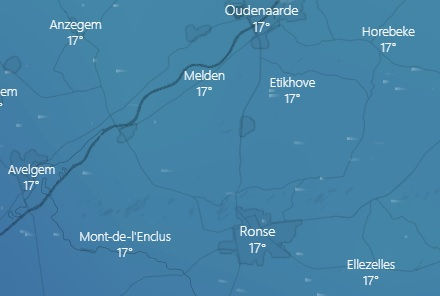
It's possible to see that the first part of the race, the whole flat section before the climbs will be raced with a tailwind with some crosswind sections. The wind will be around 5 Km/h all day long with 25-30 Km/h gusts so it won't be meaningless. If it's enough to create echelons may be a harder question, but it will certainly be enough to get the teams worried about them, and will of course make the race faster in it's opening 3 hours, which will add some more effort into the rider's day.
There are some climbs where the wind direction can play a big part, as it will be coming from east, the Taaienberg, the Oude Kwaremont and the Paterberg are those that are more exposed to the wind. The first one will face a somewhat headwind, not the ideal conditions for the attacks to appear. The second will also have a headwind in it's cover, so likely the favourites will also hinder from attacking over it.. And the Paterberg won't probably be as affected as it's a very slow climb, but unfortunately the wind will still come from the front in this sector, won't be an easy race at all to create the gaps on these climbs, but again, the wind isn't going to be extremely strong, only the gusts can cause such blockage.
The final kilometers though are obviously the most important part of the race when it comes to the wind, it can make or break the race. In this case we will have a tailwind right after the Paterberg, but the last 8.5 kilometers will be with a cross-headwind. We can assume that it shouldn't favour a lone escapee, but it also doesn't help an organized chase, it may incentivate the attacks right up to the end. But we do know that for an attack to stick it's going to have to have at least two riders, alone one won't make it like we've seen the last few years for sure.
The Prediction
The elephant in the room, every preview of these races has to begin with the mention over the Deceuninck riders. Which one? Well their favourite should be Zdenek Stybar, having won the Omloop Het Nieuwsblad and the E3 Binckbank, and has seemed the strongest rider so far in the classics, having the advantage of his very strong team. Bob Jungels has seemed Niki Terpstra's ideal replacement, his huge engine favours the long-range attacks, which is exactly the strategy Deceuninck have been using with him, but he was the only rider resisting Tiesj Benoot's attack from the pack in Dwaars door Vlaanderen some days ago, so he isn't just a threat in that form. Yves Lampaert is a long shot, but the team's strategy is something that can always play in his favour. 2017 winner Phillipe Gilbert has recently come down with a slight illness, it won't prevent him from racing but there are doubt over the level he'll be at.

Greg van Avermaet perhaps the biggest contender, Deceuninck's big rival, he opted out of Dwaars door Vlaanderen in order to prepare specifically to Sunday's race. He's been on the podium three times, he's been close to the win several times, he has a thirst to win the race tha likely no other rider has in the peloton, his team isn't as strong as some of his rivals but he definetely has the legs to be up there, will this be his year?
Unlike van Avermaet Peter Sagan has already won here, but he's also been on the Top10 plenty of times without winning, and although in some years seeming the strongest, he's always had the pressure on his shoulders, heading in as the main favourite several times due to his unique skillset. This year is no different, he remains as strong but Deceuninck's strenght in numbers overcomes their rival's individual strenght. He hasn't shown the best of forms, but he hasn't been any slouch, and he also sat up on Wednesday to be on top condition for de Ronde. Daniel Oss has also done the same, and with Lukas Postleberger aswell in the lineup Sagan will surely have a very good support with him.
The other rider who did that and should be considered top favourite is Wout van Aert. It's only his second appearance in the race, but his 9th place in the debut shows he's a natural for this type of racing. He's been showing amazing legs all spring and looks in amazing form. He packs a good sprint, and he is a very explosive rider over the bergs, perhaps his only issue is the lack of experience in relation to the others, but that doesn't seem to have held him back. In Gent-Wevelgem Jumbo-Visma had 5 riders in the final selection. Mike Teunissen has been showing great form lately and is a dangerous outsider. Danny van Poppel too but he'll likely ride more conservatively. Amund Grondahl Janse, Maarten Wynants and Taco van der Hoorn are riders who can definetely ride very strongly in this kind of agressive racing.

Those were the riders that have a very specific focus on Sunday that can "easily" win, but they aren't alone in a packed list of favourites. The image is from last year and with good reason, defending champion Niki Terpstra will be looking to defend his title. He hasn't shown the results like last year, understandibly eyeing his team change, but he has always been there so far in the classics, and his team, although initially underrated seems to be coming around. Anthony Turgis was second wednesday, Pim Lightart has a win to his name already this season in the cobbles, Adrien Petit, Alexander Pichot and Damien Gaudin are very experienced riders in the cobbles with good results to their name, and debutant Lilian Calmejane who has won in April for the last two years and his on good form.
Lotto-Soudal are coming with a three-pronged approach. Tiesj Benoot had a bad crash in the begining of the classics season, but he recovered in the meantime as has showed himself very strong on the climbs, he's defenitely a big threat, also a star debutant back in 2015. Tim Wellens hasn't focused on the cobbles, his presence wasn't expected in Flandres but he will be there, likely in support of Benoot but a very agressive rider on his own right he can have a big influence in the race. The other rider is Jens Keukeleire, he's been on the Top15 in every cobbled classic he's ridden so far this year except De Panne where he crashed near the end, he's been on great form even showing it in the sprints and he's one to look out for in the Top10, as he's also a rider who will be looking for a more free ride with his teammates set to be on the offensive.
Talking about three-pronged approaches there's another team who will target the win that way. EF come with Alberto Bettiol and Sebastian Langeveld as two of the strongest outsiders. Not two riders with an obvious call to fight for the win, but both have good chances of doing so if they get in the right move, and both have been in terrific form this season, and both will like the steep inclines very much as lightweight riders. The third rider is Sep Vanmarcke, he's been once again struck by crashes this season, but he is fit to race, and will be somewhat of a joker as no-one but himself really knows how he's riding and how his form is. It's true that it may not be his best form coming into Flandres, but none of his rivals knows what he's capable of, which may be a card for EF to play. Plus with Matti Breschel, Taylor Phinney, Tom Scully and Sacha Modolo, support will definetely not be an issue for them.

Another joker. He was reported to have had a bronchitis earlier in the week, something that has put doubt over what he can do. He's shown prestine condition all spring long but there is the issue in the back of his head for sure, it won't be psychologically easy to deal if he isn't feeling good on the day. Silvan Dillier is a strong backup but he hasn't shown his best form yet this season, there's no certainty in seeing him in the main mix in the end.
Next up is the Trek squad. Not a specific rider but the actual entire team. Trek as a whole had a very poor spring, but a really strong Gent-Wevelgem, they enter the race with what can be assumed as 4 riders with a shared lead. John Degenkolb and Edward Theuns are the more sprinter-packed riders, they should race more conservatively and both were big protagonists in GW. On the other hand we have Jasper Stuyven and Mads Pedersen, the latter was the surprise of last year, entering the break and surviving everyone except a storming Terpstra to nail a 2nd place as a mere 22-year old debutant. These two are both power riders, good for long distance attacks and should prosper in the flat terrain instead of the climbs, they both present quality options for Trek and the strenght in numbers is really not to be sniffed at for the American squad.
Team Sky is the final team with brutal strenght in numbers. Dylan van Baarle is set to lead the team after having came back from injury. Another power rider, Luke Rowe and Ian Stannard play right into his skillsets and can form a very dangerous alliance, and certainly a team who will be looking to smash the race early on. With them will be two other very explosive riders, Gianni Moscon in normal conditions would be a top favourite but only on wednesday did he finally show good signs of form, and Owain Doull, who's been affected by a nasty crash in the Nokere Koerse, but has previously had an amazing start to the cobbled races.
Entering the Unknown

If you're looking the authentic outsider this is the right call. Mathieu van der Poel's debut at World Tour level is something that's been antecipated for years, he was 4th in Gent-Wevelgem and won the Dwaars door Vlaanderen just days later. He isn't a product of hype, van der Poel is the real deal, national champion on all the disciplines he races in, just weeks ago he suffered a brutal crash but came back just days later to win the GP Denain. If van Aert is considered a strong rider imagine the rider that's used to beating him on a weekly basis during the winter. Lack of experience, lack of team are the obvious downsides, but he likes the races attacked from far and as we've seen he doesn't like to wait for others to do the damage. Perhaps this race may be too much for him according to many, but as we've seen almost every year there's a surprise result from a debutant. From van der Poel nothing would seem like a surprise, but it's a hint for what he can already achieve.
In the other side of the spectrum there's anoter debutant hungry for a result. Alejandro Valverde? Not a name you'd expect as an outsider candidate for the Tour de Flandres some years ago, specially as the 38-year old has never raced the Ronde. He's actually debuting at 38 years of age, he's had a "breakout" season last year in the cobbles, and he decided on focusing on them this season. A somewhat weird call, but the fact is he has the legs to climb with the best. What he may lack is the power on the flats, he weighs a lot less than most contenders which won't allow him to go solo, but his sprint isn't as strong as them, although he doesn pack a good end. What he can do is also unknown, but the Spanish expectations are in his shoulders, but his own expectations may be the factor that will weigh the most on him.
The Sprinters
Well not bunch sprint predicted obviously, but there are several fast riders with the conditions to dispute the race, at least in making a presence in the Top10. Matteo Trentin spearheads that group, he's been formidable in the cobbles for the last few seasons and this year it's been no different. The European champion knows how to race the long ones, he is a very powerful rider in the climbs and even more in the sprints.
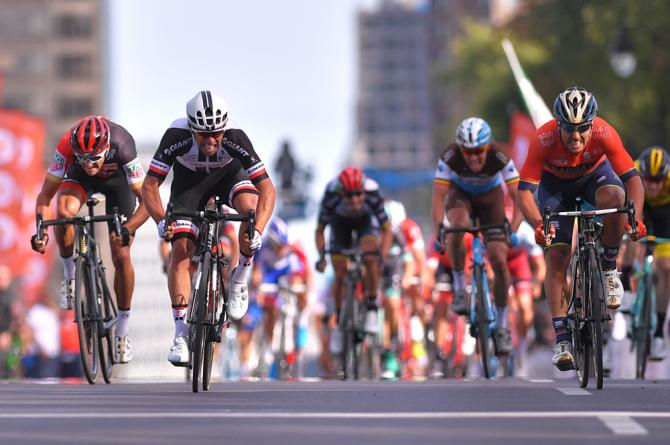
Sonny Colbrelli and Michael Matthews are two others. Matthews' doubts over form seem no issue as he won 2 stages in Catalunya, he is also actually debuting in the race, but he has some good quality experience in the other cobbled classics, which should have prepared him well for his goal here. Colbrelli was 10th here 2 years ago and also fits the needs for this race. Another one who can be benefited by the wind, the explosive efforts are his specialty alongside the sprint he can have after a hard race. Bahrain will have Matej Mohoric and Ivan Garcia Cortina so we can expect some good riding from them.
FDJ has Arnaud Démare, he's been more of a contender for this race in past years, but he still has good legs for a possible Top10, his team will be focused on him and he will be motivated by the wind conditions, with Stefan Kung as a backup or possible super-domestique. Dimension Data have Edvald Boasson Hagen and Michael Valgren in the ranks, both haven't shown much lately but they can be considered outsider obviously, but their form is very unknown and those aren't the ideal conditions to take off in a race like this.
Katusha has Nils Pollit and Jens Debusschere. Nils Pollit is actually very fancied, he is an immensely powerful rider with a strong sprint, perhaps one of the most underated riders for Flandres and Roubaix, he can be somewhat of a surprise to his rivals. Astana have Davide Ballerini and Magnus Cort Nielsen, Cofidis has Cristophe Laporte and Roompot has Lars Boom as dark horses.

The biggest dark horses though may come from UAE Emirates. Alexander Kristoff and Fernando Gaviria showed proper classic racing skills in Gent-Wevelgem. They are certainly a very functional duo, but obviously they have the climbing weakspot. Still that was no obstacle for Kristoff when he won 4 years ago, everyone at this point knows Kristoff is an expert on the longest races and it doesn't get much longer than this. Too explosive for the current way Kristoff rides, but he's been on the Top5 already 5 times, so he can handle any race situation, and he can play the antecipation card like he did in Wevelgem without being pursuited as he isn't coming as a top contender.
How Are The Teams Rated in Total Strenght
⭐⭐⭐ Sunweb, Katusha, Astana
⭐ Roompot, Cofidis, Wanty, Vital Concept, Sport Vlaanderen
Flandres, as any cobbled race, is a game of strategy and tactics. Strenght in numbers is essential, forcing rivals into working or reeling back in attacks. It's a big deal in this race, Deceuninck has won the last two editions with very strong solo rides, and the pressure of the rivals having to ride for a second Deceuninck rider is enough to take the heart out of every chase, and it allows for the classic counter-attacking tactics they dominate perfectly.
With that in mind, it's a very important race to take the strenght in numbers into account.
Prediction Time
⭐ Kristoff, Colbrelli, Matthews, Lampaert, Gilbert, Naesen, Bettiol, Mohoric, Degenkolb, Stuyven

Deceuninck lost Terpstra but they nursed a classics specialist. Jungels is the type of rider that gets the grip on every kind of terrain he rides. He reminds me of Cancellara to be honest, the most similar rider to him in the current peloton I can even say. With the last 2 wins in the bag coming from a solo attack and the constant counter-attacking and pressurizing in the chasing groups, all Jungels needs is the opportunity to get a gap and it can all be over. He will surely be marked as everyone must recognize him as a big threat, but that will maybe even open the doors for Stybar to go from far. In either ways Jungels is strong enough to climb with the best, and his resistance and thriving with the constantly moving race will give him an upper hand, perhaps the culmination of his cobbled season.
Make sure to let us in on your opinion, and of course follow us on twitter for the latest updates!



Comments